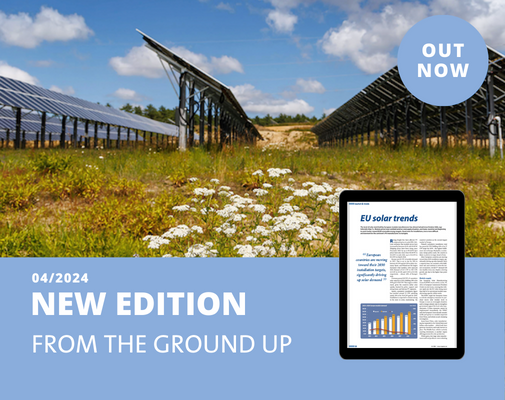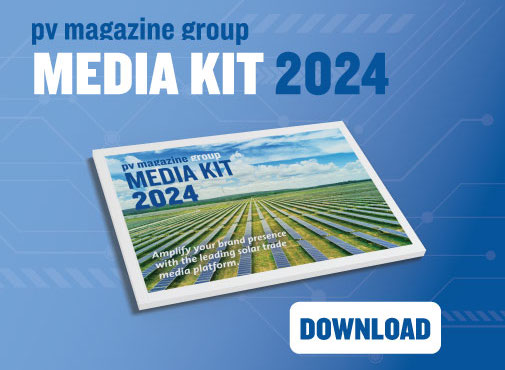Top News
Solar key to easing Burundi’s severe energy crisis
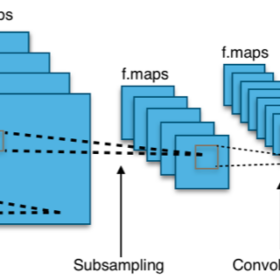
PV module fault detection technique based on convolutional neural network

Reducing photovoltaic-thermal module temperature with iron, copper oxide
pv magazine Webinar
pv magazine Webinar
MEDIA KIT 2024
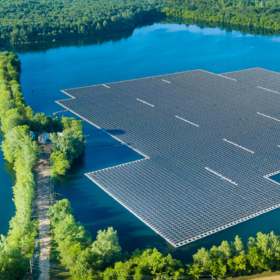
Chemitek offers new cleaning products for floating PV
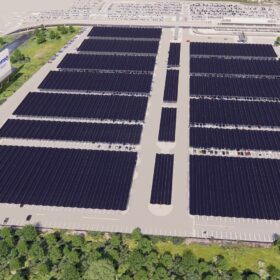
TotalEnergies builds 12 MW solar carport at New York’s JFK Airport
Sodium-ion battery could charge in several seconds
AfDB identifies key priorities for minigrid deployment in Africa
Indian startup develops sand-based gravity energy storage system
Press Releases
Better Energy more than doubled green energy production in 2023
Giga Storage announces Giraffe Energy Storage Project
Menlo Electric Launches Roadshow Across Central Europe
Astronergy upgraded its flagship 460W residential products with greener designs
Opinion & Analysis
Featured
The fastest energy change in history still underway
At least 29 countries installed more than 1 GW of PV in 2023
IEA PVPS has published its new “Snapshot of Global PV Markets 2024” report, highlighting key insights and trends. Despite record installations, concerns over profitability and manufacturing dynamics persist, underscoring the need for strategic interventions and policy support to navigate towards a resilient and sustainable PV ecosystem.
When nano- meets climate technology
The use of metal-organic frameworks (MOFs) to create nanoscale crystal structures to attract hydrogen molecules could drastically improve the energy efficiency of storing and transporting the energy carrier.
Solar module prices hovering at all-time lows
As solar module prices continue to fall, pvXchange.com founder Martin Schachinger explains how price pressure could increase in the weeks and months to come.
Dust and cloud impact solar across Arabian Peninsula
In a new weekly update for pv magazine, Solcast, a DNV company, reports that dust storms and slear skies led to contrasting March Solar Performance in West Asia. The Arabian Peninsula experienced humid winds and dust storms that reduced solar irradiance to 90% of typical levels for the month.
‘Paternity leave policies are strongly correlated with the female share of board seats’
In another article of a series on gender equality, Women in Solar Europe (WiSEu) gives voice Mariyana Yaneva, Vice Chair at the Association for production, storage and trading with electricity (APSTE). She explains that policies allowing childcare needs to be met but not placing the burden of care explicitly on women, increase the chances that women can build the business acumen and professional contacts necessary to qualify for a corporate board.
Markets & Policy
Featured
Norwegian startup unveils CO2 water-to-water heat pump
Solarge plans 500 MW BIPV module factory
Dutch module manufacturer Solarge has raised €3 million venture capital from new and existing investors to expand its recently opened facility where it produces lightweight, low carbon, panels for commercial and industrial rooftops.
SunPower to close business units, cut about 26% of workforce
The US-based company announced plans to wind down its residential solar installation locations and close its direct sales unit.
South Korea offers support for agrivoltaics
The South Korean government has announced a new package of measures to support agrivoltaic projects. It says that the agrivoltaics business should be a priority for agricultural companies.
Globeleq acquires stake in 25 MW Egyptian solar plant
London-based Globeleq has acquired a 48.3% stake in the 25 MW Winnergy solar plant in Egypt’s Benban Solar complex. It will now cooperate on the management of assets and the operation of the facility with Egyptian manufacturer GILA Altawakol Electric.
Electricity prices rising in most European markets
AleaSoft Energy Forecasting recorded electricity price increases in most major European markets during the third week of April. It says prices could continue to increase in the fourth week of April, due to rising electricity demand.
Installations
Featured
Huasun presents ‘zero busbar’ heterojunction solar modules with 23.8% efficiency
DualSun launches foldable plug-and-play solar kits
France’s DualSun has developed foldable plug-and-play solar kits with a power range of 420 W to 1.68 kW.
GameChange Solar, JZNEE to build 3 GW tracker factory in Saudi Arabia
GameChange Solar, a US-based tracker supplier, has announced the construction of a 3 GW tracker factory in Saudi Arabia, with plans for potential expansion to 5 GW in the future.
Azerbaijan announces first solar auction
Azerbaijan has revealed plans for its first renewables auction, in order to facilitate the design, financing, construction and operation of a 100 MW solar plant. Applicants can contact the Ministry of Energy from April 30 to participate in the first of two auction stages.
Spain launches 1.3 GW synchronous renewables, storage tender
The Spanish authorities are seeking 1.3 GW of clean energy and storage projects to provide flexibility, stability and security to the national electricity supply.
Kaco launches new inverters for complex roof architectures
The new products are intended for applications in commercial and industrial PV projects. The devices feature an efficiency rating of up to 98.1% and a European efficiency of up to 97.8%.
Technology
Featured
Solar-assisted heat pumps vs. air-source heat pumps
NREL updates interactive chart of solar cell efficiency
The US National Renewable Energy Laboratory (NREL) has updated its research cell efficiency chart for a range of PV technologies.
Anker Solis launches residential batteries
The new X1 can operate inside or out, from -20 C F to 55 delivering what Anker says is 100% power output without derating. The batteries are lithium iron phosphate (LiFePO4) and will reportedly remain fully operational for up to 3,000 charge cycles.
Trina Solar claims 740 W output for TOPCon PV module
The Chinese manufacturer said Germany’s TÜV SUD has confirmed the results.
Solar forecasting based on all sky imaging, long short-term memory
A Dutch research team have developed a solar radiation forecasting model that uses the long short-term memory (LSTM) technique. The proposed methodology reportedly achieves better results than other forecasting approaches.
South Korea plans 120 GW space solar project
Two Korean research institutes are designing the 2.2 km × 2.7 km Korean Space Solar Power Satellite project with the aim of providing approximately 1 TWh of electricity to the Earth per year. The proposed system should use 4,000 sub-solar arrays of 10 m × 270 m, made out of thin film roll-out, with a system power efficiency of 13.5%.
Manufacturing
Featured
JinkoSolar posts $1 billion net profit for 2023
French module makers request permits to build GW-scale panel factories
Carbon and Holosolis have both requested construction permits for 5 GW solar panel factories in France.
Chinese PV Industry Brief: China’s cumulative PV capacity tops 660 GW
China’s National Energy Administration (NEA) says the nation installed more than 47 GW of solar in the first three months of this year.
European Parliament approves law to ban products made with forced labor
The provisions cover all products and do not target specific companies or industries. They will be published in the Official Journal of the European Union tomorrow. EU member countries will have three years to enforce them.
Low solar module prices affecting secondhand market
Stefan Wippich, the CEO and co-founder of Germany’s SecondSol platform, recently spoke with pv magazine about the development of the used PV module market. Wippich noted national differences and argued that it will be important to set rules for the trading of secondhand products.
PV Cycle Belgium claims 404 tons of recycled solar panels in Q1
PV Cycle Belgium says it collected and processed 404 tons of solar panels for recycling during the first quarter of this year. It notes that the number of solar panels it has collected over the last five years has more than quadrupled.
Energy Storage
Featured
Battery makers oversubscribe India’s latest 10 GWh tender
Australia announces community battery rollout
The Australian federal government’s initiative to install 400 community batteries across the nation has reached the Australian Capital Territory, with plans for three new battery energy storage systems.
The Hydrogen Stream: Denmark may produce green hydrogen from wind
Denmark will procure at least 6 GW of offshore wind power capacity to potentially produce hydrogen, while Orlen says it will use a European Commission grant to build 16 hydrogen refueling stations in Poland.
Large-scale solar, battery storage hybrid starts operations in South Africa
Norwegian PV developer Scatec ASA has switched on a hybrid solar and battery storage facility in the Northern Cape province of South Africa.
Johnson Controls releases new residential heat pump series
The new heat pumps use R-454B as a refrigerant and are specifically designed to be matched with Johnson Controls’ residential gas furnaces. Their size ranges from 1.5 tons to 5 tons and their coefficient of performance (COP) spans between 3.24 and 3.40, according to the manufacturer.
The Hydrogen Stream: Linde plans 5 MW electrolyzer in Brazil
Linde says its White Martins unit will build a second electrolyzer to produce green hydrogen in Brazil, while Sunfire has launched a front-end engineering and design study (FEED) for a new 500 MW hydrogen project.
